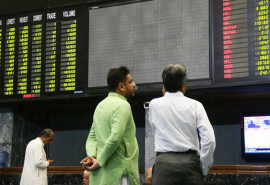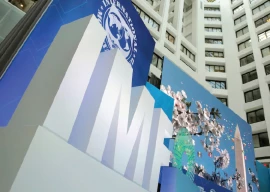
Exorbitant currency exchange rates offered by banks have discouraged scores of people from sending money home through conventional banking channels.
As an alternate, they consider digital applications useful due to stable and low fee coupled with a hassle-free transaction. Mohsin Hussain, a Pakistani student pursuing PhD at Warwick University, UK, told The Express Tribune that he sends money through a money transferring mobile app called Transferwise.
“I send around 200 pounds on a monthly basis to my family in Pakistan and the fee deducted by the app is 3.75 pounds per transaction,” he said. “I never faced any problems while using this service, hence I trust it completely.” Hussain added that he was able to save a sufficient amount by using the application as opposed to conventional banking channels because of a drastic difference between the exchange rates offered by the two.
He said that the app was a convenient option as it allowed him to send money home from anywhere and at any time. To convert currencies between countries, the app utilises exchange rates from Reuters and charges a variable transaction fee after which the amount is added to the bank account selected during the process.
According to Hussain, his family members receive the amount in two days. Endorsing Hussain’s views, Zaineb Aftab, a student from Pakistan pursuing studies in Europe, said the app helped people avoid exorbitant amounts charged by the bank for transferring money to Pakistan. “Banks offer poor exchange rates, which ultimately results in a bad deal,” she lamented. She primarily uses the service to send money home for expenditures during summers and is satisfied with the service.
Another Pakistani student in Europe stated that she found rates on the app reasonable to send money back home. According to her, it was easy to avail the facility; however, she added that the company could add support for different bank cards as well as banking accounts. Speaking about some of the problems of the application, Shahzeb Saquib, a chartered accountant working for a Dubai-based company, said, “At times, it takes longer than usual to open the website which posed a problem to me.”
On the other hand, Ohiobased Pakistani student Avinash uses Remitly to send money back home. Remitly, is an online money transfer service, which currently supports nine Pakistani banks hence money can be sent if the recipient has an account in one of those nine banks. Avinash uses Transferwise as well, however, Remitly is his preferred app “given its competitive rates which benefit me”. Sharing details, he said that he sends $500 per month to his family in Pakistan and they receive the amount within two to three days. According to him, the service fee is $2 per transaction for a transfer amount of up to $1,000.
Avinash finds the service extremely cheap and trustworthy. Wajahat Khan, a Pakistani-American filmmaker based in Los Angeles, uses Xoom money transfer service to send money home. He sends around $600-1,000 back home every month and Xoom charges him $4.99 per transaction. Although, Khan uses Remitly and Transferwise as well, his most preferred app is Xoom.
“At times if other apps offer lower exchange rate than Xoom, then I use those,” he said, adding, “I compare the amounts across multiple apps and use the one that results in the highest converted value so that my family back home can benefit.”
What the experts say
Speaking to The Express Tribune, Pakistan Software Houses Association for IT and ITeS (P@SHA) Chairman Barkan Saeed agreed that overseas Pakistanis preferred to remit their amounts back home digitally due to high exchange rates offered by the banks.
However, he was doubtful if the rising trend was a step towards digitisation stating that in the context of Pakistan, digitisation meant that the entire government machinery would be turned digital. He agreed that Covid-19 played a huge role in fuelling the trend of digital remittances. On the flip side, Prime Minister’s Task Force on IT member Pervez Iftikhar was of the view that the emerging trend of sending remittances through digital means was a step towards digitalisation.
Highlighting the difference between digitisation and digitalisation, he said in the former, information is converted into a digital format while the latter concerns with enhanced use of digital apps. Labelling Covid-19 as a silver lining, he said 80% of the boost in digitalisation witnessed since March 2020 in Pakistan, was due to Covid-19.
“The public has realised that Covid19 is here to stay hence the trajectory of digitalisation is steeping further.” Pakistanis, who had earlier never made digital payments and only dealt in cash, are now moving towards digital transactions and at present, a huge proportion of the population is paying its utility bills digitally. An official working in the remittances department in one of the leading banks of Pakistan stated that there is no doubt that the receipt of remittances through digital methods increased due to Covid-19 but still they were way below their true potential.
“Lockdown has been lifted in most countries where overseas Pakistani workers are employed, so people are again availing facilities provided by the banks to send remittances home,” he said. “White-collar workers have mostly moved towards digital apps to send money home but blue-collar workers still use banks for such transactions.” Nevertheless, the country is making full efforts to enhance and digitalise remittances, the official added.

1732063440-0/elon-(3)1732063440-0-405x300.webp)

1732062434-0/elon-(2)1732062434-0-165x106.webp)














COMMENTS
Comments are moderated and generally will be posted if they are on-topic and not abusive.
For more information, please see our Comments FAQ